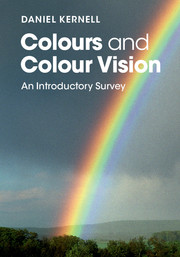Book contents
- Frontmatter
- Dedication
- Contents
- List of plates
- List of figures
- List of tables
- Preface
- 1 Colour vision in everyday life
- 2 The signals of colours: light and wavelengths
- 3 Colours and viewing conditions: not only local wavelengths
- 4 Our biological hardware: eye and brain
- 5 Eyes with unconventional properties: the ‘red-green blinds’
- 6 Other kinds of unconventional colour vision
- 7 Colour vision in different species of animals
- Appendices
- Appendix A Diagnosis and measurement of differences in colour vision
- Appendix B Specification and measurement of colours
- Appendix C Light and lighting
- Appendix D Digital cameras
- Appendix E Technical terms
- Notes
- References
- Index
- Plate section
Appendix C - Light and lighting
from Appendices
Published online by Cambridge University Press: 05 March 2016
- Frontmatter
- Dedication
- Contents
- List of plates
- List of figures
- List of tables
- Preface
- 1 Colour vision in everyday life
- 2 The signals of colours: light and wavelengths
- 3 Colours and viewing conditions: not only local wavelengths
- 4 Our biological hardware: eye and brain
- 5 Eyes with unconventional properties: the ‘red-green blinds’
- 6 Other kinds of unconventional colour vision
- 7 Colour vision in different species of animals
- Appendices
- Appendix A Diagnosis and measurement of differences in colour vision
- Appendix B Specification and measurement of colours
- Appendix C Light and lighting
- Appendix D Digital cameras
- Appendix E Technical terms
- Notes
- References
- Index
- Plate section
Summary
Wavelength and oscillation frequency of light
There is an inverse proportional relation between the wavelength (λ) and frequency (f) of light according to the formula: f = c/λ, in which c is the speed of light in a vacuum (about 300 000 km/s). For visible light, wavelength is usually measured in nanometres (nm) and the frequency in terahertz (THz). There are 109 nm per metre (i.e. 1000 million) and a frequency of 1 THz means that there are 1012 oscillations per second (i.e. a million million). The oscillation frequency of light in terahertz is obtained by dividing 300 000 by the wavelength in nanometres. Visible light has wavelengths of about 380–730 nm, which thus corresponds to oscillation frequencies of (300 000/380) to (300 000/730) = 789 to 411 THz (cf. Plate 2.4).
Light refraction
The famous speed of light of about 300 000 km/s is only valid in a vacuum, and it is then alike for all wavelengths. However, when passing through various materials the speed of light goes down, and this slowing is more marked for shortwave than for more longwave light. This slowing-down causes a light beam to change its direction (to refract) when passing an oblique borderline between two different translucent materials, e.g. at the border between air and glass (or air and water). The refraction is greater the shorter the wavelength. Hence, as was investigated by Newton in his famous experiment, light may be separated into differently coloured components by letting it pass through a glass prism (Plate 2.1b). The degree of slowing-down and the resulting refraction is different for different materials, and a measure of this property is given by the index of refraction, which is equal to the ratio between the speed of light in a vacuum and the speed in the target material. For instance, the index of refraction is 1.0003 for air, 1.33 for water, between about 1.47 and 2.04 for different kinds of glass, and unusually high for a glittering material like diamond (2.417).
Quality of lighting
Practically everything we see in the outside world depends on light reflected from various objects. For colour vision, both the quality of the light (its wavelength composition) and its intensity are of great importance. In very weak light we see no colours because we are then using only our rods.
- Type
- Chapter
- Information
- Colours and Colour VisionAn Introductory Survey, pp. 214 - 219Publisher: Cambridge University PressPrint publication year: 2016



